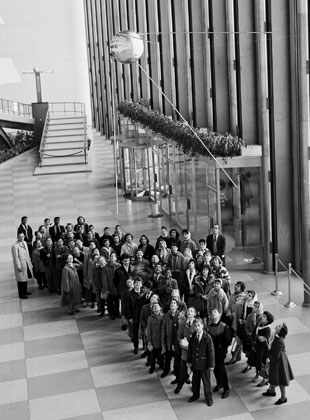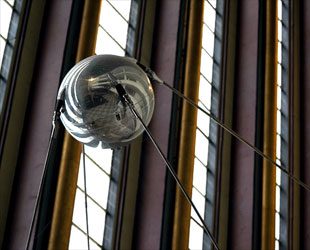September 28, 2007 — On March 2, 1962, just 10 days after making history as the first American in orbit, John Glenn visited the United Nations in New York to attend a reception in his honor and to address delegates from the then-newly formed Committee on Peaceful Uses of Outer Space. Accompanied by his fellow Mercury astronauts, Glenn suggested that the UN was the "natural center" for international teamwork in exploring space.
Underscoring his sentiment, Glenn spent a few minutes chatting with the chief delegate from the Soviet Union, who conveyed the personal congratulations from Premier Nikita Khrushchev.
According to The New York Times from that day, as he was leaving, Glenn paused to point out to his wife Annie and their family a model of Sputnik, hanging in the public lobby.

Students spy Sputnik at the UN in 1959. (UN) |
Still hanging today where the Glenns observed it 45 years ago, the Sputnik's story dates back to October 23, 1959, when the USSR announced it would present the model "as a symbol of the scientific and technical achievements of mankind in the exploration of outer space."
The stainless steel replica was ultimately presented on December 4, 1959, the same day that the UN was gifted by the Soviet Union with a sculpture by artist Evgeniy Vuchetich entitled "Let Us Beat Swords into Plowshares."
The Sputnik, suspended from the ceiling of the General Assembly building, is one of three space-related symbols now on display. Hanging nearby is a Foucault pendulum, gifted by the Netherlands in 1955, which provides visual proof of the rotation of the Earth.
The third item, a moon rock gifted by the United States in July 1970, came about as the culmination of the space race between the US and USSR that began with Sputnik.

Sputnik (replica) inside the United Nations (Pro-Zak) |
In 1999, the United Nations General Assembly declared that October 4 through October 10 each year would be World Space Week, celebrating the anniversaries of the launch of Sputnik on October 4, 1957 and the entry into force on October 10, 1967 of the Treaty Governing the Activities of States in the Exploration and Peaceful Uses of Outer Space, Including the Moon and Other Celestial Bodies, today known simply as the Outer Space Treaty.
Learn more:

